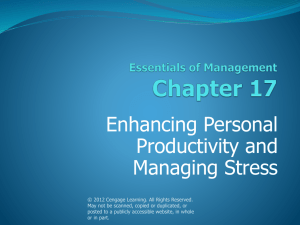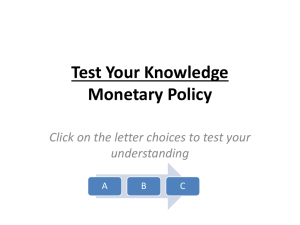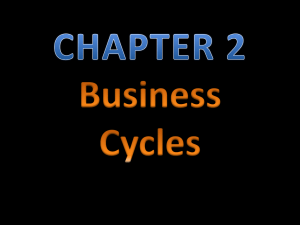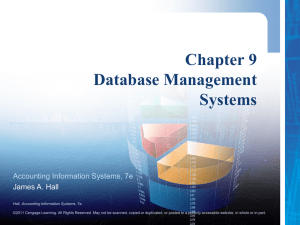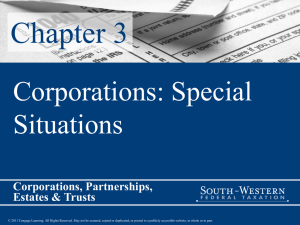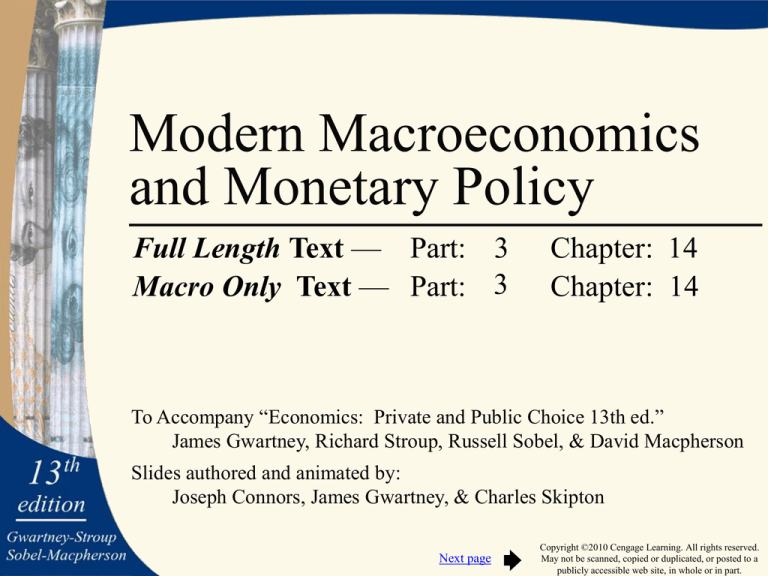
Modern Macroeconomics
and Monetary Policy
Full Length Text — Part: 3
Macro Only Text — Part: 3
Chapter: 14
Chapter: 14
To Accompany “Economics: Private and Public Choice 13th ed.”
James Gwartney, Richard Stroup, Russell Sobel, & David Macpherson
Slides authored and animated by:
Joseph Connors, James Gwartney, & Charles Skipton
Next page
Copyright ©2010 Cengage Learning. All rights reserved.
May not be scanned, copied or duplicated, or posted to a
publicly accessible web site, in whole or in part.
The Impact of Monetary
Policy on Output and Inflation
Jump to first page
Copyright ©2010 Cengage Learning. All rights reserved.
May not be scanned, copied or duplicated, or posted to a
publicly accessible web site, in whole or in part.
Impact of Monetary Policy
• Evolution of the modern view:
• The Keynesian view dominated during the
1950s and 1960s.
• Keynesians argued that the money supply
did not matter much.
• Monetarists challenged the Keynesian view
during the1960s and 1970s.
• Monetarists argued that changes in the
money supply caused both inflation and
economic instability.
• While minor disagreements remain, the
modern view emerged from this debate.
• Modern Keynesians and monetarists agree
that monetary policy exerts an important
impact on the economy. The following
slides present this modern view.
Jump to first page
Copyright ©2010 Cengage Learning. All rights reserved.
May not be scanned, copied or duplicated, or posted to a
publicly accessible web site, in whole or in part.
The Demand for Money
Money
interest
rate
Money
Demand
Quantity
of money
• The quantity of money people want to hold (the demand
for money) is inversely related to the money rate of interest,
because higher interest rates make it more costly to hold
money instead of interest-earning assets like bonds.
Jump to first page
Copyright ©2010 Cengage Learning. All rights reserved.
May not be scanned, copied or duplicated, or posted to a
publicly accessible web site, in whole or in part.
The Supply of Money
Money
interest
rate
Money
Supply
Quantity
of money
• The supply of money is vertical because it is established
by the Fed and, hence, determined independently of the
interest rate.
Jump to first page
Copyright ©2010 Cengage Learning. All rights reserved.
May not be scanned, copied or duplicated, or posted to a
publicly accessible web site, in whole or in part.
The Demand and Supply of Money
Money
interest
rate
Money
Supply
Excess supply
at i2
i2
At ie, people are willing
to hold the money supply
set by the Fed.
ie
i3
Money
Demand
Excess demand
at i3
Quantity
of money
• Equilibrium:
The money interest rate gravitates toward the rate where
the quantity of money people want to hold (demand) is
just equal to the stock of money the Fed has supplied.
Jump to first page
Copyright ©2010 Cengage Learning. All rights reserved.
May not be scanned, copied or duplicated, or posted to a
publicly accessible web site, in whole or in part.
Transmission of Monetary Policy
• When the Fed shifts to a more expansionary monetary policy,
it usually buys additional bonds, expanding the money supply.
• This increase in the money supply (shift from S1 to S2 in the
market for money) provides banks with additional reserves.
• The Fed’s bond purchases and the bank’s use of new reserves
to extend new loans increases the supply of loanable funds
(shifting S1 to S2 in the loanable funds market) … and puts
downward pressure on real interest rates (a reduction to r2).
Money
interest
rate
S1
Real
interest
rate
S1 S2
i1
r1
i2
r2
D1
Qs
Qb
S2
D
Quantity
of money
Jump to first page
Q1
Q2
Qty of
loanable
funds
Copyright ©2010 Cengage Learning. All rights reserved.
May not be scanned, copied or duplicated, or posted to a
publicly accessible web site, in whole or in part.
Transmission of Monetary Policy
• As the real interest rate falls, AD increases (to AD2).
• As the monetary expansion was unanticipated, the expansion
in AD leads to a short-run increase in output (from Y1 to Y2)
and an increase in the price level (from P1 to P2) – inflation.
• The impact of a shift in monetary policy is transmitted
through interest rates, exchange rates, and asset prices.
S1
Real
interest
rate
Price
Level
AS1
S2
r1
P2
P1
r2
D
Q1
Q2
Qty of
loanable
funds
Jump to first page
AD2
AD1
Y1 Y2
Goods &
Services
(real GDP)
Copyright ©2010 Cengage Learning. All rights reserved.
May not be scanned, copied or duplicated, or posted to a
publicly accessible web site, in whole or in part.
Transmission of Monetary Policy
Fed
buys
bonds
This
increases
money
supply
and bank
reserves
Unanticipated Expansionary
Monetary Policy
Increases in
investment &
consumption
Real
interest
rates
fall
Depreciation
of the dollar
Net exports
rise
Increase in
asset prices
Increases in
investment &
consumption
Increase in
aggregate
demand
• Here, a shift to an expansionary monetary policy is shown.
• Assume the Fed expands the supply of money by buying
bonds… which will increase bank reserves …
pushing real interest rates down … which leads to increased
investment and consumption … a depreciation of the dollar
(leading to increased net exports) and … an increase in the
general level of asset prices (and with the increased personal
wealth, increased investment and consumption).
• So, an unanticipated shift to a more expansionary monetary
policy will stimulate aggregate demand and, thereby,
increase both output and employment. Copyright ©2010 Cengage Learning. All rights reserved.
Jump to first page
May not be scanned, copied or duplicated, or posted to a
publicly accessible web site, in whole or in part.
Expansionary Monetary Policy
Price
Level
LRAS
SRAS1
P2
P1
E2
e1
AD1
Y1 YF
AD2
Goods & Services
(real GDP)
• If expansionary monetary policy leads to an in increase in AD
when the economy is below capacity, the policy will help
direct the economy toward LR full-employment output (YF).
• Here, the increase in output from Y1 to YF will be long term.
Jump to first page
Copyright ©2010 Cengage Learning. All rights reserved.
May not be scanned, copied or duplicated, or posted to a
publicly accessible web site, in whole or in part.
AD Increase Disrupts Equilibrium
Price
Level
LRAS
SRAS1
P2
P1
e2
E1
AD2
AD1
YF
Y2
Goods & Services
(real GDP)
• Alternatively, if the demand-stimulus effects are imposed
on an economy already at full-employment YF, they will
lead to excess demand, higher product prices, and
temporarily higher output (Y2).
Jump to first page
Copyright ©2010 Cengage Learning. All rights reserved.
May not be scanned, copied or duplicated, or posted to a
publicly accessible web site, in whole or in part.
AD Increase: Long Run
Price
Level
LRAS
SRAS2
SRAS1
P3
E3
P2
P1
e2
E1
AD2
AD1
YF
Y2
Goods & Services
(real GDP)
• In the long-run, the strong demand pushes up resource prices,
shifting short run aggregate supply (from SRAS1 to SRAS2).
• The price level rises (from P2 to P3) and output falls back to
full-employment output again (YF from its temp high,Y2).
Jump to first page
Copyright ©2010 Cengage Learning. All rights reserved.
May not be scanned, copied or duplicated, or posted to a
publicly accessible web site, in whole or in part.
A Shift to More
Restrictive Monetary Policy
• Suppose the Fed shifts to a more restrictive
monetary policy. Typically it will do so by
selling bonds which will:
• depress bond prices and
• drain reserves from the banking system,
• which places upward pressure on real interest
rates.
• As a result, an unanticipated shift to a more
restrictive monetary policy reduces aggregate
demand and thereby decreases both output
and employment.
Jump to first page
Copyright ©2010 Cengage Learning. All rights reserved.
May not be scanned, copied or duplicated, or posted to a
publicly accessible web site, in whole or in part.
Short-run Effects of
More Restrictive Monetary Policy
• A shift to a more restrictive monetary policy, will increase
real interest rates.
• Higher interest rates decrease aggregate demand (to AD2).
• When the reduction in AD is unanticipated, real output will
decline (to Y2) and downward pressure on prices will result.
S2
Real
interest
rate
Price
Level
AS1
S1
r2
P1
P2
r1
D
Q2
Q1
Qty of
loanable
funds
Jump to first page
AD1
AD2
Y2 Y1
Goods &
Services
(real GDP)
Copyright ©2010 Cengage Learning. All rights reserved.
May not be scanned, copied or duplicated, or posted to a
publicly accessible web site, in whole or in part.
Restrictive Monetary Policy
Price
Level
LRAS
SRAS1
P1
P2
e1
E2
AD1
AD2
YF Y1
Goods & Services
(real GDP)
• The stabilization effects of restrictive monetary policy depend
on the state of the economy when the policy exerts its impact.
• Restrictive monetary policy will reduce aggregate demand.
If the demand restraint occurs during a period of strong
demand and an overheated economy, then it may limit or
prevent an inflationary boom.
Copyright ©2010 Cengage Learning. All rights reserved.
Jump to first page
May not be scanned, copied or duplicated, or posted to a
publicly accessible web site, in whole or in part.
AD Decrease Disrupts Equilibrium
Price
Level
LRAS
P1
P2
SRAS1
E1
e2
AD2
Y2 YF
AD1
Goods & Services
(real GDP)
• In contrast, if the reduction in aggregate demand takes place
when the economy is at full-employment, then it will disrupt
long-run equilibrium, and result in a recession.
Jump to first page
Copyright ©2010 Cengage Learning. All rights reserved.
May not be scanned, copied or duplicated, or posted to a
publicly accessible web site, in whole or in part.
Proper Timing
• If a change in monetary policy is timed poorly,
it can be a source of instability.
• It can cause either recession or inflation.
• Proper timing of monetary policy is not easy:
• While the Fed can institute policy changes
rapidly, there will be a time lag before the
change exerts much impact on output & prices.
• This time lag is estimated to be 6 to 18
months in the case of output and perhaps
as much as 36 months before there is a
significant impact on the price level.
• Given our limited ability to forecast the future,
these lengthy time lags clearly reduce the
effectiveness of discretionary monetary policy
as a stabilization tool.
Jump to first page
Copyright ©2010 Cengage Learning. All rights reserved.
May not be scanned, copied or duplicated, or posted to a
publicly accessible web site, in whole or in part.
Questions for Thought:
1. What are the determinants of the demand
for money? The supply of money?
2. If the Fed shifts to more restrictive monetary
policy, it typically sells bonds. How will this
action influence the following?
a. the reserves available to banks
b. real interest rates
c. household spending on consumer durables
d. the exchange rate value of the dollar
e. net exports
f. the price of stocks and real assets like
apartments or office buildings
g. real GDP
Jump to first page
Copyright ©2010 Cengage Learning. All rights reserved.
May not be scanned, copied or duplicated, or posted to a
publicly accessible web site, in whole or in part.
Questions for Thought:
3. Timing a change in monetary policy correctly
is difficult because
a. monetary policy makers cannot act without
congressional approval.
b. it is often 6 to 18 months in the future before
the primary effects of the policy change will
be felt.
4. When the Fed shifts to a more expansionary
monetary policy, it often announces that it is
reducing its target federal funds rate. What
does the Fed generally do to reduce the
federal funds rate?
Jump to first page
Copyright ©2010 Cengage Learning. All rights reserved.
May not be scanned, copied or duplicated, or posted to a
publicly accessible web site, in whole or in part.
Questions for Thought:
5. The demand curve for money:
a. shows the amount of money balances that
individuals and business wish to hold at
various interest rates.
b. reflects the open market operations policy
of the Federal Reserve.
Jump to first page
Copyright ©2010 Cengage Learning. All rights reserved.
May not be scanned, copied or duplicated, or posted to a
publicly accessible web site, in whole or in part.
Monetary Policy
in the Long Run
Jump to first page
Copyright ©2010 Cengage Learning. All rights reserved.
May not be scanned, copied or duplicated, or posted to a
publicly accessible web site, in whole or in part.
The Quantity Theory of Money
• The quantity theory of money:
M x V = P xY
Money
Velocity
Y = Income
Price
• If V and Y are constant, then an increase in
M will lead to a proportional increase in P.
Jump to first page
Copyright ©2010 Cengage Learning. All rights reserved.
May not be scanned, copied or duplicated, or posted to a
publicly accessible web site, in whole or in part.
Long-run Impact of Monetary Policy
-- The modern View
• Long-run implications of expansionary policy:
• When expansionary monetary policy leads to
rising prices, decision makers eventually
anticipate the higher inflation rate and build it
into their choices.
• As this happens, money interest rates, wages,
and incomes will reflect the expectation of
inflation, and so real interest rates, wages, and
real output will return to their long-run normal
levels.
• Thus, in the long run, money supply growth
will lead primarily to higher prices (inflation)
just as the quantity theory of money implies.
Jump to first page
Copyright ©2010 Cengage Learning. All rights reserved.
May not be scanned, copied or duplicated, or posted to a
publicly accessible web site, in whole or in part.
Long-run Effects of a Rapid
Expansion in the Money Supply
• Here we illustrate the long-term impact of an increase in the
annual growth rate of the money supply from 3 to 8 percent.
• Initially, prices are stable (P100) when the money supply is
expanding by 3% annually.
• The acceleration in the growth rate of the money supply
increases aggregate demand (shift to AD2).
Money supply
growth rate
9
Price level
(ratio scale)
LRAS
8% growth
SRAS1
6
3
P100
3% growth
Time
periods
4
1
2
3
(a) Growth rate of the money supply.
E1
AD2
AD1
Real
GDP
YF
(b) Impact in the goods & services market.
Jump to first page
Copyright ©2010 Cengage Learning. All rights reserved.
May not be scanned, copied or duplicated, or posted to a
publicly accessible web site, in whole or in part.
Long-run Effects of a Rapid
Expansion in the Money Supply
• At first, real output may expand beyond the economy’s
potential YF … however low unemployment and strong
demand create upward pressure on wages and other resource
prices, shifting SRAS1 to SRAS2.
• Output returns to its long-run potential YF, and the price level
increases to P105 (E2).
Money supply
growth rate
Price level
(ratio scale)
LRAS
SRAS2
9
8% growth
SRAS1
6
3
3% growth
Time
periods
4
1
2
3
(a) Growth rate of the money supply.
P105
E2
P100
E1
AD2
AD1
Real
GDP
YF Y1
(b) Impact in the goods & services market.
Jump to first page
Copyright ©2010 Cengage Learning. All rights reserved.
May not be scanned, copied or duplicated, or posted to a
publicly accessible web site, in whole or in part.
Long-run Effects of a Rapid
Expansion in the Money Supply
• If the more rapid monetary growth continues, then AD
and SRAS will continue to shift upward, leading to still
higher prices (E3 and points beyond).
• The net result of this process is sustained inflation.
Money supply
growth rate
Price level
(ratio scale)
LRAS
SRAS3
SRAS2
9
P110
8% growth
E3
SRAS1
P105
6
E2
AD3
3
P100
3% growth
Time
periods
4
1
2
3
(a) Growth rate of the money supply.
E1
AD2
AD1
Real
GDP
YF
(b) Impact in the goods & services market.
Jump to first page
Copyright ©2010 Cengage Learning. All rights reserved.
May not be scanned, copied or duplicated, or posted to a
publicly accessible web site, in whole or in part.
Expansionary Monetary Policy
Loanable Funds
Market
Interest
rate
Recall: the nominal
interest rate is the
real rate plus the
inflationary premium.
rate
S2 (expected
of inflation = 5 %)
rate
S1 (expected
of inflation = 0 %)
i.09
r.04
rate
D2 (expected
of inflation = 5 %)
(expected rate
D1 of inflation = 0 %)
Q
Quantity of
loanable funds
• With stable prices, supply and demand in the loanable funds
market are in balance at a real & nominal interest rate of 4%.
• If rapid monetary expansion leads to a long-term 5% inflation
rate, borrowers and lenders will build the higher inflation rate
into their decision making.
• As a result, the nominal interest rate i will
rise to 9%.
Copyright ©2010 Cengage Learning. All rights reserved.
Jump to first page
May not be scanned, copied or duplicated, or posted to a
publicly accessible web site, in whole or in part.
Money and Inflation
• The impact of monetary policy differs
between the short and long-run.
• In the short-run, shifts in monetary policy will
affect real output and employment. A shift
toward monetary expansion will temporarily
increase output, while a shift toward monetary
restriction will reduce output.
• But in the long-run, monetary expansion will
only lead to inflation. The long-run impact of
monetary policy is consistent with the
quantity theory of money.
Jump to first page
Copyright ©2010 Cengage Learning. All rights reserved.
May not be scanned, copied or duplicated, or posted to a
publicly accessible web site, in whole or in part.
Money and Inflation
– An International Comparison 1985 - 2005
Note:
The money supply data are the
actual growth rate of the money
supply minus the growth rate of
real GDP.
1000
Rate of inflation (%, log scale)
• The relationship between
the avg. annual growth
rate of the money supply
and the rate of inflation
is shown here for the
1985-2005 period.
• The relationship between
the two is clear: higher
rates of money growth
lead to higher rates of
inflation.
Brazil
Nicaragua
Congo, DR
100
Sierra Leone
Venezuela
Mexico
Nigeria
Ghana
Columbia
Paraguay
Chile
Indonesia
10
Hungary
India
Japan
Switzerland
South Korea
Belgium
Central Africa Republic
United States
1
1
10
100
Rate of money supply growth (%, log scale)
Jump to first page
1,000
Copyright ©2010 Cengage Learning. All rights reserved.
May not be scanned, copied or duplicated, or posted to a
publicly accessible web site, in whole or in part.
Time Lags, Monetary Shifts,
and Economic Stability
Jump to first page
Copyright ©2010 Cengage Learning. All rights reserved.
May not be scanned, copied or duplicated, or posted to a
publicly accessible web site, in whole or in part.
Time Lags, Monetary Shifts, and
Economic Stability
• Shifts in monetary policy will influence the
general level of prices and real output only
after time lags that are long and variable.
• Given our limited forecasting ability, these
time lags will make it difficult for policymakers to institute changes in monetary policy
that will promote economic stability.
• Constant shifts in monetary policy are likely
to generate instability rather than stability.
• Historically, erratic monetary policy has been
a source of economic instability.
Jump to first page
Copyright ©2010 Cengage Learning. All rights reserved.
May not be scanned, copied or duplicated, or posted to a
publicly accessible web site, in whole or in part.
Measurement of Monetary Policy
• How can you tell whether monetary policy is
expansionary or restrictive?
• During the 1960s and 1970s the growth rate of
the money supply was a reasonably good
indicator of the direction of monetary policy.
Rapid growth of the money supply signaled
expansion, while slow growth or decline was
indicative of restriction.
• But innovations and dynamic change reduced
the reliability of the money growth data.
Jump to first page
Copyright ©2010 Cengage Learning. All rights reserved.
May not be scanned, copied or duplicated, or posted to a
publicly accessible web site, in whole or in part.
Measurement of Monetary Policy
• Since the mid-1980s, the Fed has used its
control over short-term interest rates more
extensively in its conduct of monetary policy.
• When the Fed shifted toward expansion, it
pushed short-term interest rates downward.
• When it shifted toward restriction, it pushed
short-term interest rates upward.
• Thus, movements of short-term interest rates
have emerged as a reliable monetary policy
indicator.
Jump to first page
Copyright ©2010 Cengage Learning. All rights reserved.
May not be scanned, copied or duplicated, or posted to a
publicly accessible web site, in whole or in part.
What is the Taylor Rule?
• Developed by John Taylor of Stanford, the
Taylor rule provides an estimate of the federal
funds interest rate that would be consistent
with both price stability and full employment.
• The Taylor rule equation for the target federal
funds rate is:
f = r + p + .5*(p-p*) + .5*(y-yp)
f - the target fed funds rate
r - equilibrium real interest rate (assumed to be 2.5%)
p - actual inflation rate
p* - the desired inflation rate (assumed to be 2%)
y - output
yp - potential output
Jump to first page
Copyright ©2010 Cengage Learning. All rights reserved.
May not be scanned, copied or duplicated, or posted to a
publicly accessible web site, in whole or in part.
What is the Taylor Rule?
• Most economists believe that price indexes
slightly overstate the rate of inflation. Thus,
the 2% desired rate of inflation might be
thought of as approximate price stability.
Jump to first page
Copyright ©2010 Cengage Learning. All rights reserved.
May not be scanned, copied or duplicated, or posted to a
publicly accessible web site, in whole or in part.
What is the Taylor Rule?
• The general idea of the Taylor Rule is
straightforward:
• When the rate of inflation is high and current
output is large relative to the potential, more
restrictive monetary policy and a higher target
fed funds rate would be appropriate.
• In contrast, when inflation is low and current
output well below its potential, more
expansionary monetary policy and a lower fed
funds rate would be called for.
Jump to first page
Copyright ©2010 Cengage Learning. All rights reserved.
May not be scanned, copied or duplicated, or posted to a
publicly accessible web site, in whole or in part.
Why is the Taylor Rule Important?
• The Taylor rule is important because it
provides both a guide for the conduct of
monetary policy and a tool for the evaluation
of how well it is being conducted.
• If the actual fed funds rate is below the target
rate implied by the Taylor rule, this indicates
monetary policy is overly expansionary.
• On the other hand, when the actual federal
funds rate is above the target rate, this signals
monetary policy is too restrictive.
• When the actual and target rates are equal, this
indicates monetary policy is on target.
Jump to first page
Copyright ©2010 Cengage Learning. All rights reserved.
May not be scanned, copied or duplicated, or posted to a
publicly accessible web site, in whole or in part.
The Taylor Rule and Monetary
Policy, 1960-2009
Actual Fed Funds Rate
Taylor Rule
Target
• The actual fed funds rate tracked the target rate quite closely
during most of the 1960s and the 1986-1999 period,
indicating that monetary policy was appropriate for the
maintenance of full employment and low inflation.
Jump to first page
Copyright ©2010 Cengage Learning. All rights reserved.
May not be scanned, copied or duplicated, or posted to a
publicly accessible web site, in whole or in part.
The Taylor Rule and Monetary
Policy, 1960-2009
Taylor Rule
Target
Actual Fed Funds Rate
• In contrast, the actual fed funds rate was substantially less
than the target rate in the inflationary 1970s and during 2002mid-year 2005.
• This indicates that monetary policy was too expansionary
Copyright ©2010 Cengage Learning. All rights reserved.
during these periods.
May not be scanned, copied or duplicated, or posted to a
Jump to first page
publicly accessible web site, in whole or in part.
Did Monetary Policy Cause the
Crisis of 2008?
• Between January 2002 and mid-year 2006,
housing prices increased by 87%.
• This boom in housing prices was fueled by
several factors including:
• government regulations that eroded lending
standards and promoted the purchase of
housing with little or no down payment
• heavily leveraged borrowing for the financing
of mortgage-backed securities
• But, the expansionary Fed policy of 20022004, followed by the shift to a more
restrictive monetary policy in 2005-2006 also
contributed to the housing boom and
subsequent bust.
Jump to first page
Copyright ©2010 Cengage Learning. All rights reserved.
May not be scanned, copied or duplicated, or posted to a
publicly accessible web site, in whole or in part.
Short-Term Interest Rates, 19982009
Federal Funds
1-Year T-Bill
• Rising short-term interest rates are indicative of monetary
restriction, while falling rates imply expansion.
• Note, how the Fed pushed short-term interest rates to historic
lows during 2002-2004, and housing prices soared.
Jump to first page
Copyright ©2010 Cengage Learning. All rights reserved.
May not be scanned, copied or duplicated, or posted to a
publicly accessible web site, in whole or in part.
Inflation, 1998-2009
• As inflation rose in 2005-2006, the Fed shifted toward
restriction and pushed short-term interest rates upward.
• The Fed’s low interest rate policy (2002-2004), followed by
its more restrictive policy (2005-2006), contributed to the
boom and bust in housing prices, and the Crisis of 2008.
Jump to first page
Copyright ©2010 Cengage Learning. All rights reserved.
May not be scanned, copied or duplicated, or posted to a
publicly accessible web site, in whole or in part.
Current Fed Policy and the Future
• As the recession worsened during the second
half of 2008, the Fed shifted toward a highly
expansionary monetary policy.
• Vast amounts of reserves were injected into
the banking system, short-term interest rates
were pushed to near zero, and the monetary
base was approximately doubled.
• Monetary policy works with a lag. It will take
some time for the expansionary monetary
policy to stimulate demand and economic
recovery.
Jump to first page
Copyright ©2010 Cengage Learning. All rights reserved.
May not be scanned, copied or duplicated, or posted to a
publicly accessible web site, in whole or in part.
Current Fed Policy and the Future
• The Fed now faces a dilemma: If it shifts
toward restriction too quickly, the recovery
may falter. But, if the Fed continues with the
expansionary monetary policy for too long, it
will lead to serious future inflation.
• The problem is not the Fed’s ability to control
the money supply, but its ability to time shifts
properly. Given the long and variable lags, it
is hard for monetary policy-makers to institute
stop-go policy in a stabilizing manner.
• We are in the middle of another great
monetary policy experiment.
Jump to first page
Copyright ©2010 Cengage Learning. All rights reserved.
May not be scanned, copied or duplicated, or posted to a
publicly accessible web site, in whole or in part.
Questions for Thought:
1. When the actual interest rate is less than the rate
implied by the Taylor rule, monetary policy is
too expansionary. (True or False?)
2. Will stop-go monetary policy help stabilize
real output and employment? Why or why
not?
3. Did Fed policy contribute to the Crisis of
2008? Why or why not?
4. Did the change in Fed policy during the latter
half of 2008 help promote economic
recovery? Did this policy change lead to
long-term stability?
Jump to first page
Copyright ©2010 Cengage Learning. All rights reserved.
May not be scanned, copied or duplicated, or posted to a
publicly accessible web site, in whole or in part.
End
Chapter 14
Jump to first page
Copyright ©2010 Cengage Learning. All rights reserved.
May not be scanned, copied or duplicated, or posted to a
publicly accessible web site, in whole or in part.


